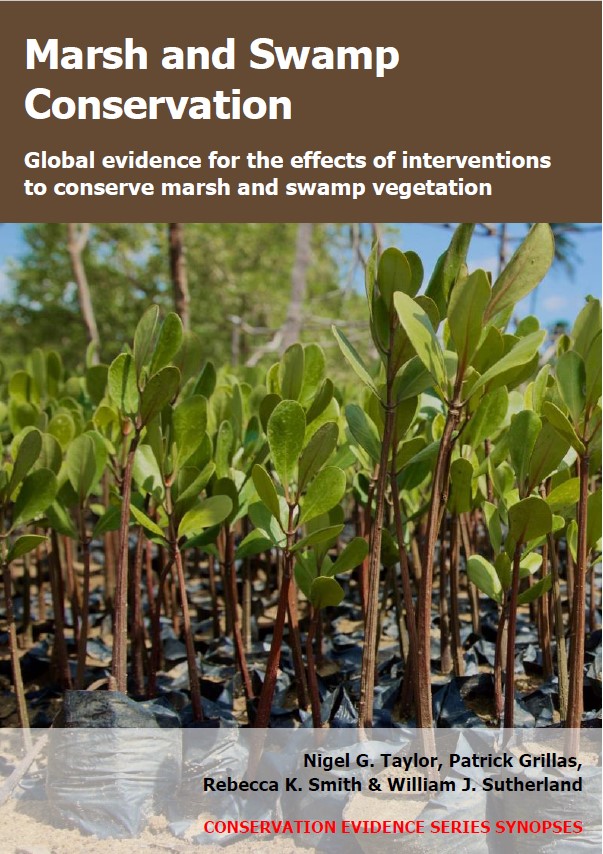Designate protected area
-
Overall effectiveness category Likely to be beneficial
-
Number of studies: 4
View assessment score
Hide assessment score
How is the evidence assessed?
-
Effectiveness
50% -
Certainty
40% -
Harms
10%
Study locations
Supporting evidence from individual studies
A study in 1908–2006 of a sustainably managed mangrove forest in Peninsular Malaysia (Chong 2006) reported that it retained at least 97% of its mangrove coverage over this period. Mangrove coverage may even have increased slightly, through colonization of newly deposited sediments. For context, the study reports 16% loss of mangrove forest coverage across Malaysia between 1973 and 2000, but an increase of around 6% in Perak State (where the studied managed forest is located) between 1980 and 2000. Methods: The Matang Mangrove Forest Reserve has been protected and managed with sustainable, rotational wood harvesting since 1908. The study does not report details of the methods used to monitor mangrove coverage. Most data are taken from previously published sources.
Study and other actions testedA replicated, site comparison study in 1977–2002 of 97 mangrove forest sites in Puerto Rico (Martinuzzi et al. 2009) reported that site-level protection had no clear effect on mangrove forest area. Statistical significance was not assessed. Between 1977 and 2002, the total area of mangrove forest increased by 10% in protected sites (from 4,440 to 4,900 ha), 9% in partially protected sites (part protected, part unprotected; from 1,880 to 2,050 ha) and 15% in unprotected sites (from 1,090 to 1,250 ha). Considering individual sites, mangrove area increased in 52% of protected sites, 53% of partially protected sites and 40% of unprotected sites. Mangrove area decreased in 18% of protected sites, 17% of partially protected sites and 25% of unprotected sites. Methods: The study was based on historical estimates of mangrove forest area in 97 discrete sites across Puerto Rico, derived from aerial photos or satellite images. Note that site-level protection of mangroves in Puerto Rico occurs against a background of general legal protection of these habitats since 1972.
Study and other actions testedA replicated study in 2000–2012 of 28 protected areas in northeast China (Lu et al. 2016) reported that the area of marsh and swamp within them decreased over time. Statistical significance was not assessed. The combined area of marshes and swamps decreased by 9% between 2000 and 2012, from 8,444 km2 to 7,724 km2. The area of natural aquatic habitats (rivers and lakes) decreased by 16%, from 5,805 km2 to 4,886 km2. The biggest cause of these losses was conversion to cropland (responsible for 39% of the area of marsh/swamp/aquatic habitat lost). The study also reported “degradation” of the landscape-scale structure of marsh/swamp/aquatic habitats in 21 of the 28 protected areas (reported as an index based on metrics such as the size, shape and separation of habitat patches). Methods: Twenty-eight protected areas were studied. They had been established between 1979 and 2003 (22 before 2000). All but one contained areas of marsh and/or swamp. Most were probably freshwater but some were probably brackish/saline (not explicitly reported). Land cover was determined from satellite images taken in summer or autumn 2000 and 2012. Classifications were verified in the field. Rainfall was similar in both years for each protected area (statistical significance not assessed).
Study and other actions testedA before-and-after study in 1972–2013 of a protected area in northwest China (Yu et al. 2017) reported that the area of wetland habitat declined despite protection, and that the habitat became more fragmented. Statistical significance was not assessed. The study site was protected as a National Nature Reserve in 2007. Between 2007 and 2013, wetland area declined from 657 km2 to 588 km2. For comparison, wetland covered 755 km2 in 1972 and 798 km2 in 1998. Between 2007 and 2013, the wetland habitat also became more fragmented, comprised of more, smaller patches with more complex borders (data reported as landscape metrics). This was a return towards the habitat configuration recorded in 1972 and 1998. The study also noted increasing rainfall, temperature, human population and farmland area near the study site. Methods: Land cover on the site of Ebinur Lake Wetland National Nature Reserve was mapped in two years before protection (1972, 1998) and two years after protection (2007, 2013). The date of protection was verified for this summary using Zhang et al. (2019). Data sources included satellite images, photos and GPS data. Wetland habitat excluded water bodies.
Additional Reference: Zhang F., Yushanjiang A. & Jing Y. (2019) Assessing and predicting changes of the ecosystem service values based on land use/cover change in Ebinur Lake Wetland National Nature Reserve, Xinjiang, China. Science of the Total Environment, 656, 1133–1144.
Study and other actions tested
Where has this evidence come from?
List of journals searched by synopsis
All the journals searched for all synopses
This Action forms part of the Action Synopsis:
Marsh and Swamp Conservation
Marsh and Swamp Conservation - Published 2021
Marsh and Swamp Synopsis





)_2023.JPG)














